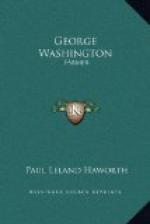The young groom and farmer—as he would now have styled himself—was at this time not quite twenty-seven years old, six feet two inches high, straight as an Indian and weighed about one hundred and seventy-five pounds. His bones and joints were large, as were his hands and feet. He was wide-shouldered but somewhat flat-chested, neat-waisted but broad across the hips, with long arms and legs. His skin was rather pale and colorless and easily burned by the sun, and his hair, a chestnut brown, he usually wore in a queue. His mouth was large and generally firmly closed and the teeth were already somewhat defective. His countenance as a whole was pleasing, benevolent and commanding, and in conversation he looked one full in the face and was deliberate, deferential and engaging. His voice was agreeable rather than strong. His demeanor at all times was composed and dignified, his movements and gestures graceful, his walk majestic and he was a superb horseman[2].
[2] Adapted from a description written by his comrade-in-arms, George Mercer.
The bride brought her husband a “little progeny” consisting of two interesting stepchildren; also property worth about a hundred thousand dollars, including many negro slaves, money on bond and stock in the Bank of England. Soon we find him sending certificates of the marriage to the English agents of the Custis estate and announcing to them that the management of the whole would be in his hands.
The dower negroes were kept separate from those owned by himself, but otherwise he seems to have made little distinction between his own and Mrs. Washington’s property, which was now, in fact, by Virginia law his own. When Martha wanted money she applied to him for it. Now and then in his cash memorandum books we come upon such entries as, “By Cash to Mrs. Washington for Pocket Money L4.” As a rule, if there were any purchases to be made, she let George do it and, if we may judge from the long list of tabby colored velvet gowns, silk hose, satin shoes, “Fashionable Summer Cloaks & Hatts,” and similar articles ordered from the English agents she had no reason to complain that her husband was niggardly or a poor provider. If her “Old Man”—for she sometimes called him that—failed in anything she desired, tradition says that the little lady was in the habit of taking hold of a button of his coat and hanging on until he had promised to comply.
He managed the property of the two children with great care and fidelity, keeping a scrupulous account in a “marble colour’d folio Book” of every penny received or expended in their behalf and making a yearly report to the general court of his stewardship. How minute this account was is indicated by an entry in his cash memorandum book for August 21, 1772: “Charge Miss Custis with a hair Pin mended by C. Turner” one shilling. Her death (of “Fitts”) in 1773 added about ten thousand pounds to Mrs. Washington’s property, which meant to his own.




